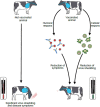Review on bovine respiratory syncytial virus and bovine parainfluenza - usual suspects in bovine respiratory disease - a narrative review
- PMID: 34332574
- PMCID: PMC8325295
- DOI: 10.1186/s12917-021-02935-5
Review on bovine respiratory syncytial virus and bovine parainfluenza - usual suspects in bovine respiratory disease - a narrative review
Abstract
Bovine Respiratory Syncytial virus (BRSV) and Bovine Parainfluenza 3 virus (BPIV3) are closely related viruses involved in and both important pathogens within bovine respiratory disease (BRD), a major cause of morbidity with economic losses in cattle populations around the world. The two viruses share characteristics such as morphology and replication strategy with each other and with their counterparts in humans, HRSV and HPIV3. Therefore, BRSV and BPIV3 infections in cattle are considered useful animal models for HRSV and HPIV3 infections in humans.The interaction between the viruses and the different branches of the host's immune system is rather complex. Neutralizing antibodies seem to be a correlate of protection against severe disease, and cell-mediated immunity is thought to be essential for virus clearance following acute infection. On the other hand, the host's immune response considerably contributes to the tissue damage in the upper respiratory tract.BRSV and BPIV3 also have similar pathobiological and epidemiological features. Therefore, combination vaccines against both viruses are very common and a variety of traditional live attenuated and inactivated BRSV and BPIV3 vaccines are commercially available.
Keywords: BPIV3; BRD; BRSV; Bovine Parainfluenza; Bovine respiratory disease; Bovine respiratory syncytial virus; Review; Vaccines.
© 2021. The Author(s).
Conflict of interest statement
BM is an employee of MSD Animal Health, the company that markets the vaccines and pharmaceuticals to prevent and treat BRSV and BPIV3.
Figures






Similar articles
-
Assessment of Risk Factors Related to Environmental Factors and Herd Management for Bovine Respiratory Syncytial Virus and Bovine Parainfluenza Virus-3 Infections Frequently Observed in Beef and Dairy Cattle.Vet Med Sci. 2025 Jul;11(4):e70299. doi: 10.1002/vms3.70299. Vet Med Sci. 2025. PMID: 40460209 Free PMC article.
-
Bovine viral diarrhea viral infections in feeder calves with respiratory disease: interactions with Pasteurella spp., parainfluenza-3 virus, and bovine respiratory syncytial virus.Can J Vet Res. 2000 Jul;64(3):151-9. Can J Vet Res. 2000. PMID: 10935880 Free PMC article.
-
Comparative efficacy of modified-live and inactivated vaccines in boosting responses to bovine respiratory syncytial virus, bovine parainfluenza virus Type 3, and bovine coronavirus following neonatal mucosal priming of beef calves.Can Vet J. 2024 Aug;65(8):791-801. Can Vet J. 2024. PMID: 39091482 Free PMC article.
-
Bovine respiratory syncytial virus.Vet Clin North Am Food Anim Pract. 2010 Jul;26(2):323-33. doi: 10.1016/j.cvfa.2010.04.010. Vet Clin North Am Food Anim Pract. 2010. PMID: 20619187 Review.
-
Bovine respiratory syncytial virus infection: immunopathogenic mechanisms.Anim Health Res Rev. 2007 Dec;8(2):207-13. doi: 10.1017/S1466252307001405. Anim Health Res Rev. 2007. PMID: 18218161 Review.
Cited by
-
Mannheimia haemolytica Negatively Affects Bovine Herpesvirus Type 1.1 Replication Capacity In Vitro.Microorganisms. 2022 Oct 31;10(11):2158. doi: 10.3390/microorganisms10112158. Microorganisms. 2022. PMID: 36363750 Free PMC article.
-
Cross-sectional seroprevalence study of bovine herpesvirus 1, bovine respiratory syncytial virus, and parainfluenza virus 3 in cattle from Villavicencio, Colombia.BMC Vet Res. 2025 Jan 16;21(1):24. doi: 10.1186/s12917-024-04461-6. BMC Vet Res. 2025. PMID: 39819649 Free PMC article.
-
Prevalence of three Mycoplasma sp. by multiplex PCR in cattle with and without respiratory disease in central Mexico.Trop Anim Health Prod. 2022 Nov 22;54(6):394. doi: 10.1007/s11250-022-03398-y. Trop Anim Health Prod. 2022. PMID: 36417039 Free PMC article.
-
Protection against Bovine Respiratory Syncytial Virus Afforded by Maternal Antibodies from Cows Immunized with an Inactivated Vaccine.Vaccines (Basel). 2023 Jan 9;11(1):141. doi: 10.3390/vaccines11010141. Vaccines (Basel). 2023. PMID: 36679988 Free PMC article.
-
Biochemistry of the Respiratory Syncytial Virus L Protein Embedding RNA Polymerase and Capping Activities.Viruses. 2023 Jan 25;15(2):341. doi: 10.3390/v15020341. Viruses. 2023. PMID: 36851554 Free PMC article. Review.
References
-
- ICTV . Virus Taxonomy: 2018b Release. 2018.
-
- Bukreyev A, Yang L, Fricke J, Cheng L, Ward JM, Murphy BR, Collins PL. The secreted form of respiratory syncytial virus G glycoprotein helps the virus evade antibody-mediated restriction of replication by acting as an antigen decoy and through effects on fc receptor-bearing leukocytes. J Virol. 2008;82(24):12191–12204. - PMC - PubMed
Publication types
MeSH terms
LinkOut - more resources
Full Text Sources
Medical

